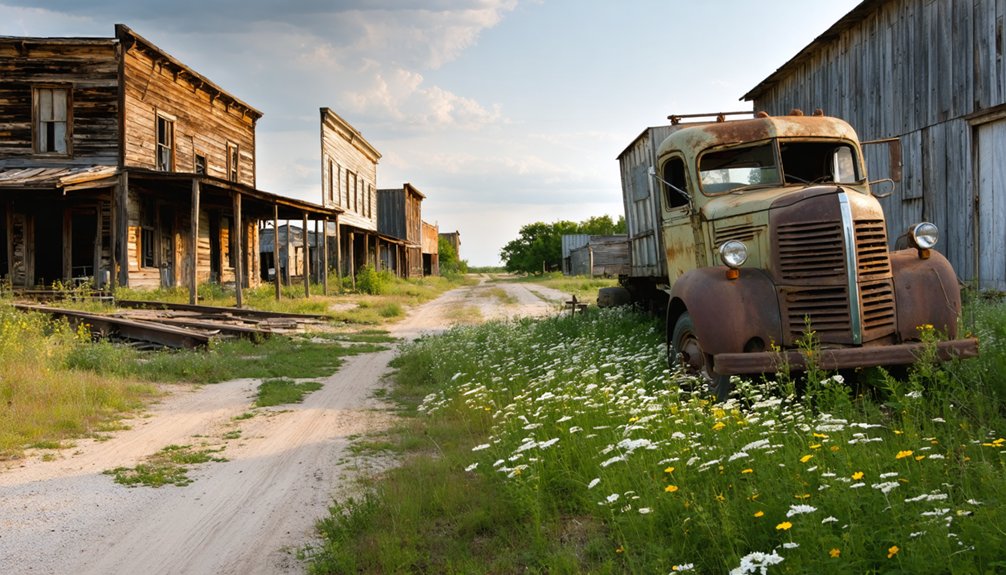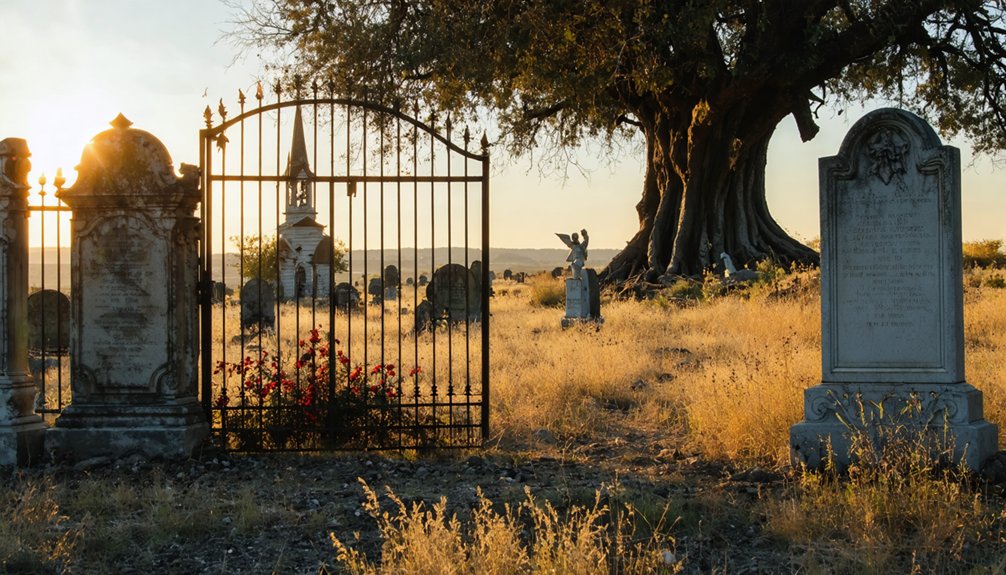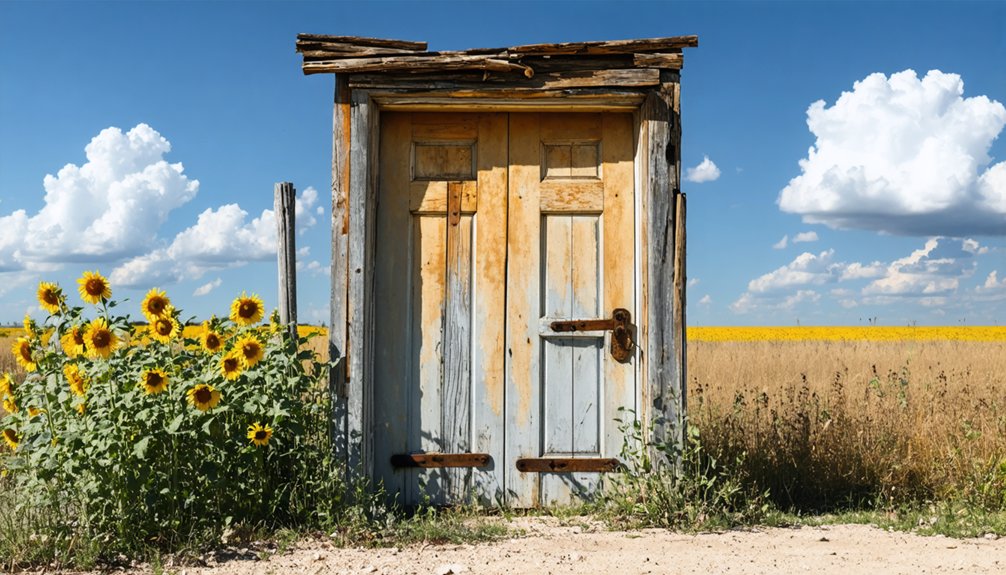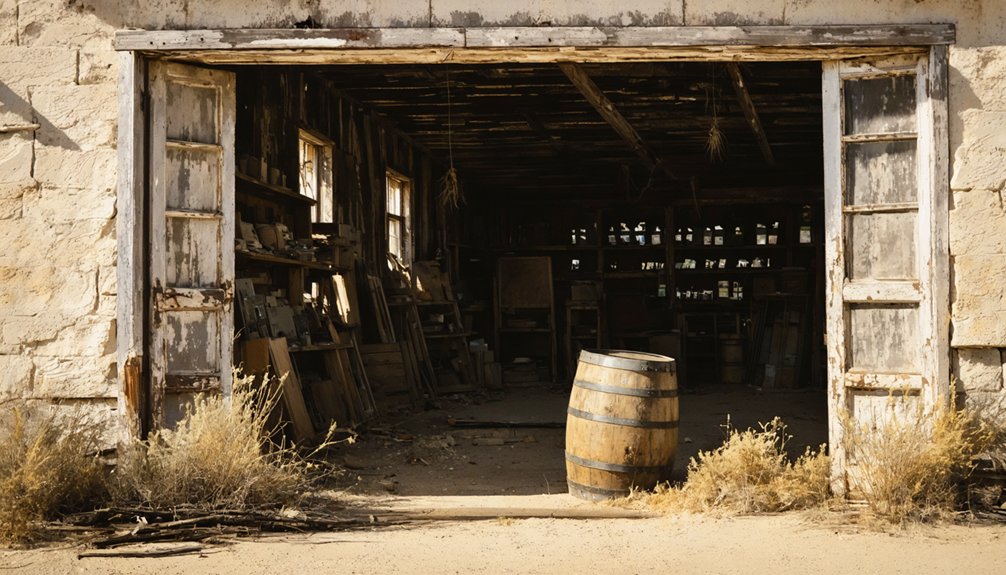You’ll find Graball, Texas – a ghost town located near Rocky Creek in Washington County – among countless lost communities that once thrived during Texas’ post-independence era. By 1892, this close-knit farming settlement peaked at 100 residents, with cotton and corn driving its economy. While the town declined after being bypassed by railroads, five small cemeteries remain as silent witnesses to its past. The stories these burial grounds tell paint a fascinating picture of early Texas life.
Key Takeaways
- Graball was a thriving 19th-century farming community near Navasota, Texas that declined after being bypassed by the railroad.
- The town reached its peak around 1892 with 100 residents, three general stores, and a drugstore before becoming abandoned.
- Cotton and corn farming dominated the local economy, with livestock operations contributing 75% of farm income by 1900.
- Only five small cemeteries remain as physical evidence of the former settlement, including the historically marked Graball Cemetery.
- Economic factors, agricultural mechanization, and youth migration to urban centers led to Graball’s complete abandonment.
Origins and Early Settlement
While many Texas settlements emerged along major transportation routes, Graball took root in a more modest location near Rocky Creek, approximately 2 miles from Navasota in Washington County.
You’ll find its origins tied to the settlement patterns of post-independence Texas, when pioneers sought promising locations along waterways and fertile lands.
The community drew settlers during the 19th century frontier era, including European immigrants who’d ventured to Texas seeking new opportunities. Like many Texas communities, Graball’s prosperity depended heavily on its single industry focus, primarily agriculture.
Though Graball never received formal designation as a major town, you’ll discover evidence of its established presence through community structures, particularly its cemeteries.
The settlement’s agrarian foundation reflected the typical rural character of Washington County’s small communities during the early years of Texas statehood. Texas now contains 511 ghost towns, a testament to the changing fortunes of frontier settlements like Graball.
Life in 19th Century Graball
Despite its modest size, Graball flourished as a close-knit farming community of roughly 100 residents by 1892, anchored by diverse settler families including Germans and Alabamians who’d established deep roots in the Texas soil.
You’d find community dynamics centered around essential gathering places where neighbors forged strong bonds and shared resources. Much like the Tomball Rebekah Lodge, these gathering spots became cornerstones for local fellowship and support. The spirit of preservation was similar to the Texas Historical Commission sites that now protect the state’s diverse cultural heritage.
Daily life revolved around these key social gatherings:
- Church services and religious meetings that unified the settlers
- Lodge assemblies where professionals and laborers mingled as equals
- Multifunctional buildings serving as post offices, general stores, and meeting halls
Kinship networks strengthened the community’s fabric through shared labor during harvests and cattle drives.
Amos Gates, the oldest resident by 1883, exemplified the pioneering spirit that shaped Graball’s character before the railroad’s arrival brought significant changes.
Agricultural Legacy and Economy
You’ll find that cotton dominated Graball’s agricultural economy in the late 19th and early 20th centuries, while corn served the dual purpose of food staple and livestock feed. The economic growth of the region was significantly enhanced by the expansion of railways in the late 1800s.
The area’s farmers maintained substantial livestock operations, with cattle, poultry, and hogs contributing roughly 75% of farm income by the 1900s. Like many Texas farming communities, Graball’s agricultural success was built on historical farming practices that had shaped the state since Spanish colonization.
Local trade networks centered around small general stores and drugstores, where agricultural goods supported commerce within the community and connected Graball to larger markets in Washington County.
Cotton and Corn Production
Cotton emerged as a transformative force in Graball and the Texas High Plains during the late 19th century, beginning with pioneering experiments by local ranchers around 1890.
Following the pattern of early Texas cotton history, local farmers adopted tenant farming systems where workers received half to two-thirds of cotton profits while working landowners’ fields.
You’ll find that early cotton varieties proved highly adaptable to the region‘s conditions, with farmers carefully selecting the best-performing seeds for future plantings.
The agricultural landscape evolved through these key developments:
- Cotton acreage doubled between 1890-1900, often covering over 50% of farmland
- Local cotton gins and processing infrastructure rapidly expanded, handling thousands of bales
- Corn hybrids emerged as complementary crops, with yields increasing from 25 to 120 bushels per acre by 1980
This agricultural freedom let you rotate between cotton and corn, maximizing both soil health and profits while adapting to the region’s unique growing conditions.
By the mid-19th century, corn production dominated Texas agriculture, with farmers harvesting over six million bushels in 1849.
Livestock Grazing Operations
Beyond the fields of cotton and corn, Graball’s agricultural heritage ran deep through its extensive livestock operations.
During the post-Civil War boom, local ranchers joined the massive expansion westward that saw cattle numbers grow into the millions across Texas and beyond.
You’d find ranchers adapting their grazing practices from the open-range traditions of the 1800s to more regulated systems under the Taylor Grazing Act. Like many Texas ranching communities, Graball’s operators learned hard lessons about stocking density and ecological restoration after witnessing the devastating impacts of overgrazing in the late 19th century.
As railroads connected the region to broader markets, local ranchers shifted from subsistence operations to cash-generating enterprises. With emerging research, ranchers recognized the importance of maintaining well-aggregated soil to better capture water during periods of drought and flooding.
They eventually embraced rotational grazing methods better suited to the semi-arid climate, allowing native grasslands to recover between grazing periods. This evolution in land management helped preserve the delicate balance between livestock production and rangeland health.
Local Trade Networks
While Graball’s agricultural roots stretched back to its 1876 founding, the town’s economic significance centered on a network of three general stores and a drugstore by 1884.
The community connections fostered through these establishments created crucial trade dynamics that supported nearly 100 residents at its peak in 1892.
You’ll find Graball’s trade networks were shaped by three key factors:
- Cotton and corn production drove local commerce, with cotton gins supporting textile supply needs.
- Strategic location near Rocky Creek and the Navasota River facilitated agricultural transport.
- Local merchants provided essential supplies to farming families until railroad bypasses disrupted established trade routes.
Unfortunately, when railroads favored nearby towns like Brenham, Graball’s economic isolation led to its eventual decline and ghost town status.
Transportation Networks and Trade Routes

As railroads expanded across Washington and Grimes counties in the late 19th century, Graball’s significance as a trading center began to wane.
You’ll find the transportation evolution dramatically shifted when rail lines bypassed the town, redirecting established trade dynamics away from communities that once thrived on stagecoach routes and waterway proximity.
While you could’ve found Graball strategically positioned near Rocky Creek and the Navasota River, these natural trade corridors lost their influence as rail transport dominated the region.
Despite Graball’s prime location along waterways, the rise of railroads diminished these once-vital trade routes to mere geographic features.
The town’s connection to broader markets suffered without a railroad stop, even though it maintained local road networks.
What you’re seeing is a classic example of how transportation infrastructure shaped Texas communities’ destinies – those with rail connections flourished, while bypassed towns like Graball faced inevitable decline.
The Decline and Abandonment
When railroads bypassed Graball in the late 19th century, the town’s fate began an irreversible decline typical of many rural Texas communities. Economic factors steadily eroded the town’s viability, while demographic changes accelerated its abandonment.
You’ll find that Graball’s story mirrors many Texas ghost towns that couldn’t adapt to modernization.
The town’s collapse followed three distinct phases:
- Loss of commercial activity as businesses relocated to better-connected areas
- Exodus of younger residents to urban centers seeking employment opportunities
- Closure of essential services like the post office, making daily life unsustainable
Without rail connections and facing agricultural mechanization that reduced labor needs, Graball couldn’t maintain its population.
The community gradually dispersed as remaining families sought opportunities in larger towns with stronger economies and better infrastructure.
Cemetery Chronicles and Family Stories

You’ll find the history of Graball preserved in its multiple cemeteries, including the Evans Prairie Cemetery with 139 documented memorials and the larger Friedens Church Cemetery containing 682 burial records.
The town’s early settlers and their descendants rest in several family plots, such as the Gates-Perry, Hinds, and Micajah Byrd gravesites, while some burial grounds like the Rock Island Cemetery near the Brazos River have succumbed to neglect and bulldozing.
These sacred grounds tell silent stories through their weathered markers, from the prominent grave of Amos Gates, one of Austin’s Old Three Hundred settlers, to the unmarked plots of African American residents who shaped the community’s political landscape in the 1880s.
Ancestral Burial Grounds Found
The discovery of Graball Cemetery stands as the most tangible remnant of this vanished Texas community, located near Rocky Creek just two miles from the Navasota River in northeastern Washington County.
You’ll find ancestral connections preserved through burial traditions that reflect the area’s rich cultural heritage, particularly among Black residents who formed the majority of the population in the 1880s.
The cemetery’s historical significance is highlighted by:
- A Texas historical marker honoring Amos Gates, one of the Old Three Hundred settlers
- Five small registered cemeteries in the vicinity, forming a cluster of burial grounds
- Tombstones and markers that tell the stories of early settlers and their descendants
These burial grounds remain essential for genealogists and historians studying local heritage, despite challenges in documentation and preservation.
Lost Names, Silent Stories
Standing silently among overgrown grass and weathered stones, Graball’s five small cemeteries chronicle the untold stories of families who once called this Washington County settlement home.
You’ll find clusters of family plots dating from the late 1800s through early 1900s, their inscriptions revealing lost legacies of the area’s early settlers. These forgotten histories, etched in deteriorating markers, hint at the tight-knit kinship groups that shaped the community before its decline.
As Graball’s economy faltered and railroads bypassed the town, families dispersed to nearby counties and urban centers, leaving their ancestral burial grounds behind.
Now, with scarce records and fading oral traditions, these cemetery remnants offer your only glimpse into the lives of those who built, then reluctantly abandoned, this vanished Texas community.
Washington County’s Lost Community
Located within the historically rich expanse of Washington County, Texas, Graball emerged as a small but significant African American community during the late 19th century.
The community’s dynamics reflected the broader changes sweeping through post-Civil War Texas, with political tensions reaching a boiling point during the 1886 election.
You’ll find Graball’s story marked by three defining characteristics:
- A strong African American majority, with black voters outnumbering whites five to one
- Active political participation despite fierce opposition, including ballot box destruction by masked men
- A place within Washington County’s agricultural economy, surrounded by farms and early industrial ventures
Today, Graball stands as a symbol of the struggle for freedom and representation in rural Texas, though its physical presence has faded into history.
Remnants and Physical Evidence Today

If you visit Graball today, you’ll find five small cemeteries documented on Find a Grave as the main physical remnants of this former Washington County community.
The Graball Cemetery features a Texas historical marker commemorating early settler Amos Gates, while no original buildings or commercial structures remain standing at the site.
The cemeteries serve as geographical anchors near Rocky Creek, providing essential historical evidence of the settlement’s original location and its inhabitants.
Cemetery Sites
The Graball Cemetery remains one of the few tangible links to this vanished Texas community, serving as a historical landmark in northeastern Washington County.
You’ll find forgotten markers scattered across this sacred ground, where memorial traditions once honored both early settlers and African American Republican community members.
A Texas historical marker pays tribute to Amos Gates, one of the Old Three Hundred settlers, while the cemetery’s location near Rocky Creek helps pinpoint where this ghost town once thrived.
When exploring this historic site, you’ll notice:
- Weathered grave markers reflecting the region’s pioneering spirit
- Natural vegetation characteristic of Washington County’s terrain
- Evidence of the community’s diverse heritage through burial patterns and memorial styles
Building Foundations Today
While the cemetery preserves memories of Graball’s past residents, physical evidence of the town’s buildings has largely disappeared over time.
If you’re interested in ghost town archaeology, you’ll find that Graball’s foundation preservation is minimal, with only scarce remnants of the once-thriving 1880s community remaining.
The general stores and drugstore that served the town have deteriorated beyond recognition, leaving little more than scattered stone and brick footings hidden beneath decades of vegetation.
You’ll discover that, like many abandoned Texas settlements, Graball’s structural remains are limited to crumbled masonry fragments – typical of sites that reverted to pastureland after their decline.
The absence of rail infrastructure meant fewer durable building investments, accelerating the loss of physical evidence over the century since abandonment.
Exploring Graball’s Historic Sites
Modern-day explorers of Graball’s historic sites must navigate through minimal infrastructure and natural overgrowth to discover what remains of this former agricultural community.
As you venture into this ghost town near Rocky Creek, you’ll find historic landmarks scattered across Washington County’s rural landscape, preserving community memories of a bygone era.
When exploring Graball’s remnants, keep these essential points in mind:
- Five local cemeteries serve as primary historical markers, offering glimpses into the area’s past residents.
- Building foundations and deteriorated structures require careful navigation due to safety concerns.
- You’ll need to rely on personal research and preparation, as there’s limited signage or guided assistance.
Remember to respect private property boundaries and bring necessary supplies, as there aren’t any modern amenities available.
Preserving Local Heritage
Preserving Graball’s local heritage requires coordinated efforts between historical societies, property owners, and community volunteers who work tirelessly to protect and document this remarkable ghost town.
You’ll find community engagement at the heart of preservation efforts, with local groups organizing guided tours and educational walks that help protect fragile structures while sharing the town’s rich history.
These initiatives face preservation challenges, particularly with complex property ownership records and zoning regulations that affect restoration work. The Graball Cemetery’s historic markers represent a significant achievement in formalizing protection under state programs.
To experience this heritage firsthand, you can join interpretive tours led by knowledgeable guides who’ll share authentic stories while ensuring controlled access that protects these irreplaceable historical sites for future generations.
Frequently Asked Questions
Were There Any Notable Crimes or Lawlessness Reported in Graball’s History?
While you won’t find many typical crime incidents or law enforcement records, the KKK’s violent destruction of ballot boxes in 1886 marked the town’s most significant documented act of lawlessness.
What Native American Tribes Originally Inhabited the Graball Area?
You’ll find Comanche and Apache tribes dominated the area’s Indigenous heritage, with Comanche exerting stronger tribal influence after pushing Apache groups southeast during their expansion from the north in the 1700s.
Did Any Famous Personalities or Historical Figures Visit Graball?
You might expect a small Texas town to boast famous visitors and historical connections, but there’s no documented evidence of any notable personalities or historical figures ever visiting Graball.
What Was the Highest Recorded Population of Graball?
You won’t find a documented highest population for this town – despite tracking population growth and demographic changes in Texas ghost towns, reliable records weren’t kept of Graball’s peak resident count.
Were There Any Natural Disasters That Significantly Impacted the Town?
You won’t find documented evidence of major flood damage or drought effects specifically impacting Graball. While the town’s location near Rocky Creek suggests flood vulnerability, no confirmed natural disasters are recorded.
References
- https://www.navasotaexaminer.com/article/community-columns/graball-washington-county-ghost-town
- https://texashighways.com/travel-news/four-texas-ghost-towns/
- https://txprobatelawyer.net/the-rise-of-ghost-towns-can-you-own-a-piece-of-abandoned-texas/
- https://www.youtube.com/watch?v=phjUE19A8HM
- https://www.ghostsandgetaways.com/ghost-towns
- https://en.wikipedia.org/wiki/List_of_ghost_towns_in_Texas
- https://texashistory.unt.edu/explore/collections/TGTN/
- https://www.texasescapes.com/CentralTexasTownsSouth/Graball-Texas.htm
- https://www.texasescapes.com/CentralTexasTownsSouth/Maysfield-Texas.htm
- https://www.lonestartreasure.com/texas-ghost-towns-and-their-buried-riches/



